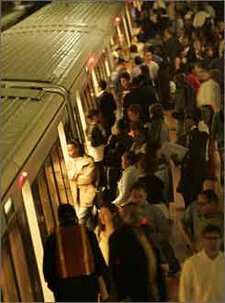 US rail transit under surveillance [Graphic: TSA]
The Light Rail Now Project can be contacted at: Light Rail Now! |
Like shopping malls, government buildings, and virtually all facilities accessible to large numbers of people, public transport facilities and vehicles are vulnerable to attack by vandals, extremists, terrorists, and other criminals – and clearly some precautionary measures are justified. However, as we've seen with recent hysteria over transit and railway photography (see Security and Civil Liberties Issues), prudent precaution can mutate into policies that are harmful, disruptive, and counter-productive.
In recent years, many public transport professionals and advocates have been troubled by what they perceive to be a growing climate of hysteria and repressive practices that has been engulfing the public transport industry, with federal Transportation Security Administration (TSA) and Homeland Security authorities apparently trying to lead public transport agencies in the direction of screening virtually all passengers (particularly in rail systems). Furthermore, as Light Rail Now has repeatedly documented, suspicion of rail photographers has been encouraged, resulting in some cases in harrassment of photographers and draconian prohibitions against public photography. There is ongoing concern that these policies and trends may degrade the quality of public transportation, harshen the experience for public transport passengers, and discourage ridership. Moreover, as LRN has further noted,
In hopes of fostering policies rooted more in facts than speculation, fear, suspicion, and hysteria, the Light Rail Now Project has sponsored a research effort, undertaken by research associate Susan Pantell, to establish a more solid and reliable basis of data and analysis for evaluating the efficacy and justification of the new public transport security emphasis. A particular objective of the Light Rail Now Project's research has been to address questions such as those raised above, and to ascertain their relative significance, by performing a statistical tally of all terrorist attacks involving transportation facilities and categorizing these into various transport mode groupings:
The research project has covered the 41-year period 1967-2007, with the primary base of data consisting of the enumeration of terrorist attacks published by the US State Department, Wikipedia, and other sources indicated below. Sifting through these incidents, Susan Pantell's effort has produced a tally for each of the various categories indicated above, with only attacks actually involving transportation vehicles or facilities being tallied. Sources have included the following:
The results of Susan Pantell's research are presented in the table below.
The chart below graphically illustrates the percentage of total incidents by mode.
It is clear from these data that the proportion of rail-related incidents is extremely small and that most terrorist attacks involve either motor vehicles or air transport, with a smaller percentage involving buses/facilities or watercraft/facilities. Indeed, as a whole, all forms of surface public transport together account for just 16% of total incidents. Thus, the legitimate question arises: With rail services and facilities implicated in only about 3% of total incidents, why are rail passenger services being singled out for special security crackdowns – when nearly 3/4 of all incidents involve private motor vehicles, which nowhere are being subjected to such measures? Why does the TSA seem to be on a policy mission to create as difficult an environment as possible for public transport passengers, especially while virtually ignoring the private motor vehicle travel that clearly accounts for the overwhelming majority of transportation terrorism incidents?
Surely, statistics must form a basis for policy. Those who have fueled anti-terrorism hysteria have persisted in pointing to worldwide incidents to justify tightening access to public transport, especially rail, in this country. Yet the worldwide data in this analysis themselves suggest a relatively minor association of rail passenger operations with terrorism. Moreover, if one focuses only on terrorist incidents in the USA, then there would seem to be little to no basis whatsoever for targeting rail passenger services, urban or intercity, for a special security crackdown: there has been no major terrorist incident at all involving these modes in the USA. Indeed, with the possible exception of one or two isolated attacks by apparently deranged individual passengers inside buses, it is difficult to identify any "terrorist" incidents on any American surface public transport. On the other hand, the most egregious terrorist incidents in recent memory – the Oklahoma City bombing of the Murrah Building (1995), the first World Trade Center bombing (1993), and the disastrous 2001 WTC bombing, all involved either private motor vehicles or air transport. Air transport (which clearly has been shown to be quite vulnerable, and, along with motor vehicles, a favored target – and instrument – of terrorists) has been subjected to a comparatively rigorous security crackdown; on the other hand, private motor vehicle movement has been subjected to basically nothing in terms of comparable ongoing security measures. Thus, again, it is pertinent to ask: why is rail travel targeted so prominently by America's Homeland Security authorities? A tentative conclusion would be that the current US surface transportation security policy emphasis focusing on terrorism in rail facilities (e.g., massive surveillance and screening operations in New York City, Washington, and Boston, as well as extensive photo bans or restrictions in a number of rail transit systems) would appear to be far out of proportion to the demonstrated actual threat, and that priorities are misplaced – particularly when there is no comparable surveillance or screening of motor vehicles and facilities. Light Rail Now! website
| |||||||||||||||||||||||||||||||||||||||||||||||||||||||||||||||||||||||||||||||||||
|
|
||||||||||||||||||||||||||||||||||||||||||||||||||||||||||||||||||||||||||||||||||||